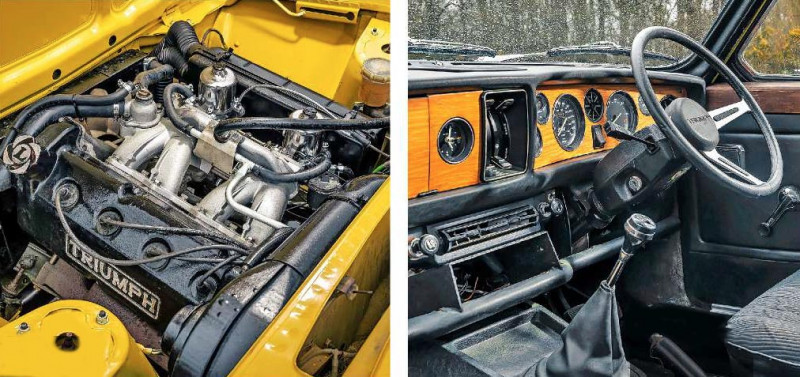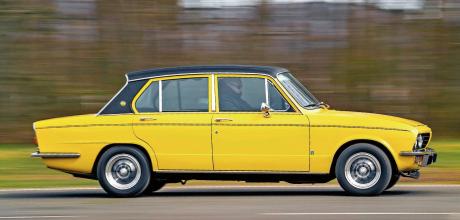1973 Triumph Dolomite Sprint
By the Seventies the sports saloon had really come of age. Ford showed that, because of motor sport success, it could sell ship-loads of Escorts. Other makers wanted a slice of the action – Triumph chief among them, with the Dolomite deemed an ideal base for something fruity. Led by Rover’s Spen King, the Triumph Dolomite Sprint engineers won a Design Council award for the new model’s innovative single-cam, 16-valve cylinder head – and British Leyland advertising literature of the time incorporated one of the best puns of the era, ‘The award has gone to our head’.
This is an early Sprint (car number 1527), a fact denoted by its striking Mimosa Yellow paint. This sunny shade was the only colour Sprints came in from their introduction until August 1973. The cabin has elements of both the Magnette and the Cortina, with wood and vinyl accoutrements along with seats as bolster-less as our earlier pairing, although at least the Sprint’s pews offer prodigiously deep cushioning. The ride proves equally forgiving on my lower back.
It’s impossible to ignore that clever slant-four engine, which emits conspicuously sportier notes than anything of the other cars we’ve sampled thus far. Performance is peaky, as expected for a 16-valve engine, although there’s also a decent amount of torque. Keeping below 3500rpm, you still have enough urge to get around in most situations, though where’s the fun in that? Taking the engine speed up into its top range provokes a guttural growl as the pair of HD6 SU carburettors suck in ever-increasing volumes of air and fuel. Home in on the engine’s 5700rpm redline and you’re rewarded with a distinctive yowl as the 2.0-litre unit emerges into its powerband and forward momentum builds with renewed vigour.
Despite this Sprint approaching quinquagenarian status, its power delivery feels far more up-to-date than the previous cars’. Perhaps it’s because we’ve been spoiled by so many excellent 16-valve four-cylinders since. Whatever the cause, Triumph engineers should be applauded, though we do mourn that 32-valve V8 engine (two Sprint motors) we could have had. The engine might be the undisputed star of the show, but its chassis is also worthy of praise; just as well, because carrying speed in the bends is preferable to trying to use the brakes. Hitting the centre pedal feels like standing on a semi-thawed 12oz steak – there’s no feel whatsoever. The Sprint’s braking system was essentially made from the stoppers of the Dolomite 1850 with revised front pads and a pressure regulator for the larger rear drums. An odd decision, with enlarged rear brakes – especially drums – having little effect on overall performance.
Despite its shortcomings, this old Triumph has a nimble nature that makes it great fun to chuck about. The gearchange is pretty accurate and fast but get too carried away and you’ll crunch a synchro. The steering’s light on the move yet weighty as the front axle digs in, before understeer takes over. Lots more throttle mid-corner breaks the inner tyre’s traction – this Sprint lacking the optional limited-slip differential – though backing off doesn’t prove either surprising or scary. You can easily exploit every bit of 127bhp performance this fun little car has.
Sprints have traditionally been one of the cheapest routes into Seventies performance. That situation seems to finally be changing – and once again, it’s a rival Ford that’s pushing up values. Escort Mexico values have taken on a ballistic trajectory and those priced out have looked around for something cheaper, with the go-faster Dolomite making an excellent alternative. Rusty but complete project cars that used to be priced at £500 are now fetching £2500 – and you’ll need to double that latter figure for something worth having. Add another £5000 to that for the very best examples. Having emerged from what’s often regarded as the worst period of industrial output in the history of British car production, if a Sprint hasn’t been bodged by its former owners, then it probably was at the factory. Keep a keen eye out for water ingress in the cabin and crusty steel under a vinyl top. Most problems come more from the cars being worth very little for a long time rather than inherent flaws – but either way, you need to do your homework before breaking into Sprint ownership.
‘The engine is the star of the show, but its chassis is also worthy of praise’
Owning a Dolomite Sprint
Chris Earle runs Sprint specialist Savage Works Restoration, based in Nuneaton, so all he does all day every day is look after Dolomites. ‘My old man had a Magenta Sprint and I always wanted one of my own. It was the memories of that car that really got me into them. I didn’t get around to it for a while, but one day I bought one… and then another and another. Now I have around 20 of them. I like them as a stock standard car; they just drive so much better if they haven’t been messed around with. ‘This one was restored by a previous owner around 13 years ago, but it’s a car that’s always been on the road. We put a new vinyl roof on and painted it. The only thing I’ve done is buy new brakes from the Dolomite Sprint Club, which was brilliant for all the hard-to-get parts.’
TECHNICAL DATA 1973 Triumph Dolomite Sprint
- Engine 1998cc, inline four-cylinder (slant four), sohc 16-valve, twin SU HS6 34 carburettors
- Max Power 127bhp @ 5700rpm;
- Max Power 122lb ft @ 4500rpm
- Transmission All-synchromesh four-speed manual with optional overdrive, rear-wheel drive
- Steering Rack & pinion
- Suspension Front: independent coil sprung struts with hydraulic telescopic dampers, upper wishbone with lower control arm. Rear: de Dion axle with radius arms, coil springs and hydraulic telescopic dampers.
- Brakes Servo-assisted discs front, drums rear
- Performance 0-60mph: 9.1sec.
- Top speed: 116mph
- Weight 1015kg (2237lb)
- Fuel consumption 24mpg
- Cost new £1740
- Classic Cars Price Guide £5000-15,000

Slant-four 16v is rev-happy but there’s grunt too. The Sprint lives up to its name. It’s nimble as well. Wooden dash and bolster-free seats (but they are plump).


